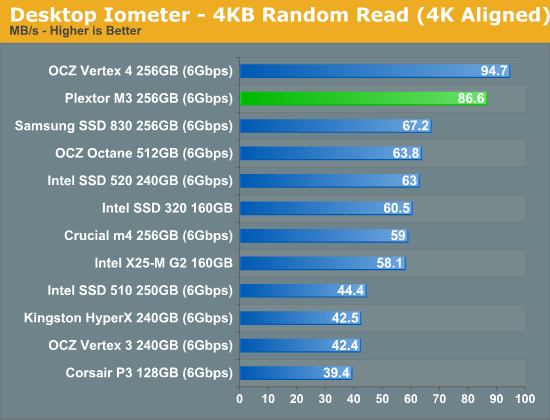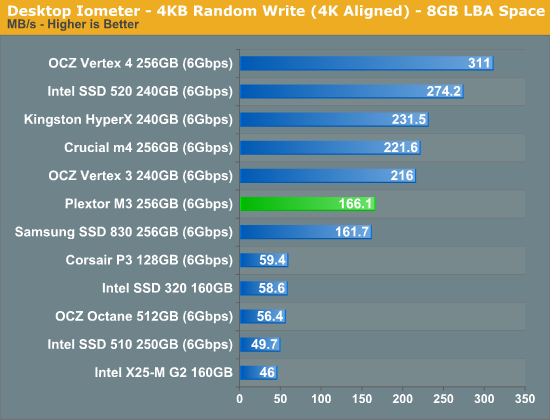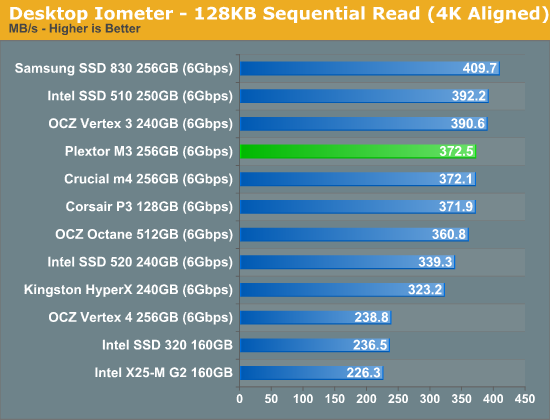The Plextor M3 (256GB) Review
by Kristian Vättö on April 5, 2012 3:05 AM ESTRandom and Sequential Read/Write Speed
The four corners of SSD performance are as follows: random read, random write, sequential read and sequential write speed. Random accesses are generally small in size, while sequential accesses tend to be larger and thus we have the four Iometer tests we use in all of our reviews. Our first test writes 4KB in a completely random pattern over an 8GB space of the drive to simulate the sort of random access that you'd see on an OS drive (even this is more stressful than a normal desktop user would see). We perform three concurrent IOs and run the test for 3 minutes. The results reported are in average MB/s over the entire time. We use both standard pseudo randomly generated data for each write as well as fully random data to show you both the maximum and minimum performance offered by SandForce based drives in these tests. The average performance of SF drives will likely be somewhere in between the two values for each drive you see in the graphs. For an understanding of why this matters, read our original SandForce article.

Plextor M3 provides very good 4KB random read performance. Looking at the Crucial m4 that uses the same Marvell controller, the Plextor M3 is 47% faster in random performance, so Plextor has clearly paid attention to their firmware.

Random write performance is not as great as random read but still quite good enough for most workloads. This time Crucial's m4 comes out 33% faster than the M3, while the SF-2281 drives are all faster as well—write less data thanks to realtime compression and data deduplication techniques and your write speeds should generally be faster.

Switching the queue depth to 32 shows the difference between SandForce and non-SandForce quite well. SandForce is in its own class but among the Marvell SSDs, the Plextor M3 is the fastest. It's important to note that only heavy I/O workloads use queue depths that reach 32; most usage models don't go over 5.
Sequential Read/Write Speed
To measure sequential performance we ran a one minute long 128KB sequential test over the entire span of the drive at a queue depth of 1. The results reported are in average MB/s over the entire test length.

Sequential read speed is identical to Crucial m4 and Corsair P3, and good if not class leading for a SATA 6Gbps SSD.

In sequential write speeds, the M3 is once again the fastest Marvell based SSD and is only a few percent behind SandForce based SSDs.










113 Comments
View All Comments
Pr101 - Thursday, April 5, 2012 - link
Yeah, you just happened to do a review when other ssds were low in price/on sale and the Plextor was high/not on sale. I'd also use m4 prices of the ones that come with a 2.5 to 3.5 bracket for comparison. Anyway, nice review...Kristian Vättö - Thursday, April 5, 2012 - link
I checked the prices one week apart (updated the prices so they wouldn't be that old) and Plextor was the most expensive throughout this period. Other drives are actually more expensive now than they were a week ago. But yeah, the prices fluctuate a lot so it's fairly hard to recommend one just based on prices.SetiroN - Thursday, April 5, 2012 - link
For its bundle, warranty and overall performance (never at the top but in every case amongst the top drives), I'd easily consider this the best drive on the market.As much as I understand the reliability concerns, Plextor is well known for their quality control, and for them to offer 5 yrs I'm pretty sure you can feel safe about it. This is not OCZ we're talking about.
TBH I find it silly to ask for a $10 discount when competitors are offering much less in terms of warranty and bundling.
Kristian Vättö - Thursday, April 5, 2012 - link
I'm not saying that the drive is not worth the extra $10, but it can be hard for a buyer to justify the extra. There are free utilities that do the cloning job as well (although shareware is usually easier to use). I also think that most consider 3-year warranty to be 'good enough'.Especially 64GB is all about price as you're already making a compromise by getting such a small SSD.
7Enigma - Thursday, April 5, 2012 - link
Shockingly after dealing with 2 failed attempts at using freeware (EASEus and another program) I ended up having sucess with the Windows 7 Image backup and built in drive manager.I was going from a new laptop 500GB HDD with about 92GB on it to a 128GB Crucial M4. First thing was to reduce the size of the partition on the 500GB to less than 128. This wasn't as easy as it sounded as apparently the page file gets randomly placed on the drive. in my case it was placed at the middle of the platter and so I couldn't shrink the 500GB partition down until I first temporarily set the page file to 0MB and then repartitioned. After figuring out that little quirk and repartitioning down to under 95GB I did a recovery image onto an external HDD (this was a laptop with a single drive bay).
Then using the bootable recovery windows cd I simply swapped out the old 500GB drive for the new M4 SSD, booted with the recovery disk, pointed to the image on the external drive, and sat back and within the hour (very slow external HDD!) was back up and running perfectly.
Sure some of those other pay-for programs are probably easier to use, but this one didn't require any additional software (other than downloading Windows recovery cd), and a bit of hair-pulling to work out the quirks.
JarredWalton - Thursday, April 5, 2012 - link
I've used Clonezilla quite a few times, but I wish they would add a feature to allow you to shrink a clone to a smaller drive (assuming the data will all fit). You pretty much have to do the same thing you just mentioned: eliminate the swap file and hibernate file, resize the partition to less than your target size, then clone/Rick83 - Thursday, April 5, 2012 - link
It would be interesting to see not only power consumption measures, but also max-load efficiency values.In the "race-to-idle" scenario, that we want to see on mobile hardware, it can often be beneficial to consume a little extra power during a short time span, but then allow the entire system to idle as early as possible.
Knowing the Watts per Throughput ratio could be helpful, and allow an easier comparison of effective/actual power consumption.
Kristian Vättö - Thursday, April 5, 2012 - link
I totally agree. Power consumption during sequential/random write does not give the big picture. A fast drive with high peak power consumption may consume less power overall because it does the job faster than a slower drive with lower peak power.Ideally, I think it would be the best to measure how much power was used during our Heavy/Light test suites, that would be a more real life scenario. How to do that accurately is another question, but I'll definitely keep this in mind :-)
James5mith - Thursday, April 5, 2012 - link
Anyone who has been involved in computers since the time of the first CD burners knows Plextor. Their 16x10x40 CD-RW drives were the cream of the crop and highly prized. I still have one despite not having an IDE channel to plug it into. I just can't bring myself to toss it.Spawn73 - Thursday, April 5, 2012 - link
You´d must´ve been living in a hole to not have heard of Plextor. They're famous for their high quality CD-burners.Couldn't the reviewer Wiki the company or something before making a blanket statement about a company being unknown?